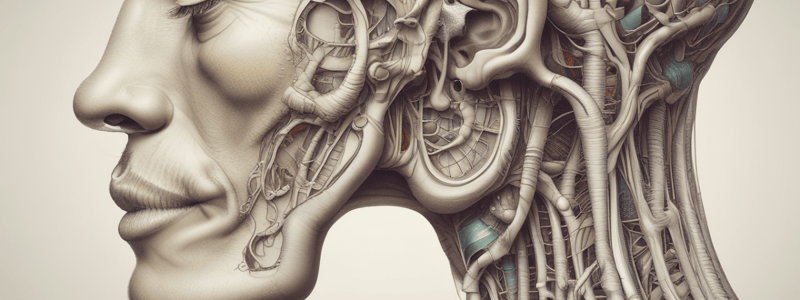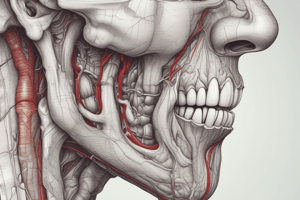Podcast
Questions and Answers
What is the primary function of turbinates in the nasal cavity?
What is the primary function of turbinates in the nasal cavity?
- To increase the air pressure in the nasal cavity
- To produce mucus and other fluids
- To direct the air flow towards the sinuses
- To warm and humidify the air (correct)
What is the result of the turbulent airflow caused by the turbinates?
What is the result of the turbulent airflow caused by the turbinates?
- The air is dried out more efficiently
- The air is heated more efficiently
- The air is moved more quickly through the nasal cavity
- The air is filtered more efficiently (correct)
What is the material composition of the turbinates?
What is the material composition of the turbinates?
- A combination of bone and cartilage (correct)
- Only bone
- Muscle and connective tissue
- Only cartilage
What is a byproduct of the humidifying function of the turbinates?
What is a byproduct of the humidifying function of the turbinates?
What is the overall effect of the turbinates on the air we breathe?
What is the overall effect of the turbinates on the air we breathe?
Turbinates are only made of bone.
Turbinates are only made of bone.
The primary function of turbinates is to humidify the air.
The primary function of turbinates is to humidify the air.
Turbinates in the nasal cavity trap foreign particles in mucus.
Turbinates in the nasal cavity trap foreign particles in mucus.
Turbinates cool the air in the nasal cavity.
Turbinates cool the air in the nasal cavity.
Conchae is another name for turbinates.
Conchae is another name for turbinates.
Match the function of turbinates with the corresponding process:
Match the function of turbinates with the corresponding process:
Match the structure of turbinates with the corresponding characteristic:
Match the structure of turbinates with the corresponding characteristic:
Match the effect of turbinates on air with the corresponding result:
Match the effect of turbinates on air with the corresponding result:
Match the location of turbinates with the corresponding cavity:
Match the location of turbinates with the corresponding cavity:
Match the alternative name for turbinates with the corresponding term:
Match the alternative name for turbinates with the corresponding term:
What is the primary function of the cells lining the sinuses?
What is the primary function of the cells lining the sinuses?
What is a benefit of having sinuses in the skull?
What is a benefit of having sinuses in the skull?
What is the purpose of the mucus produced by the sinuses?
What is the purpose of the mucus produced by the sinuses?
What is the location of the sinuses in the skull?
What is the location of the sinuses in the skull?
How many sinuses are there in the skull?
How many sinuses are there in the skull?
The sinuses are located outside the nasal cavity.
The sinuses are located outside the nasal cavity.
There are three sinuses in the skull.
There are three sinuses in the skull.
The mucus produced by the sinuses is used to humidify the air.
The mucus produced by the sinuses is used to humidify the air.
The skull would be heavier without sinuses.
The skull would be heavier without sinuses.
The sinuses produce cells that trap foreign particles.
The sinuses produce cells that trap foreign particles.
Match the following structures with their corresponding locations:
Match the following structures with their corresponding locations:
Match the following functions with the corresponding structures:
Match the following functions with the corresponding structures:
Match the following benefits with the corresponding structures:
Match the following benefits with the corresponding structures:
Match the following descriptions with the corresponding structures:
Match the following descriptions with the corresponding structures:
Match the following processes with the corresponding structures:
Match the following processes with the corresponding structures:
What is the primary function of the ridges on the hard palate?
What is the primary function of the ridges on the hard palate?
What is the difference between the hard and soft palate?
What is the difference between the hard and soft palate?
What is a potential issue with brachycephalic dogs and their soft palate?
What is a potential issue with brachycephalic dogs and their soft palate?
What separates the oropharynx and nasopharynx?
What separates the oropharynx and nasopharynx?
What is the location of the hard palate in the mouth?
What is the location of the hard palate in the mouth?
The hard palate is a soft muscular tissue at the back of the mouth.
The hard palate is a soft muscular tissue at the back of the mouth.
The soft palate is located at the front of the mouth.
The soft palate is located at the front of the mouth.
The ridges on the hard palate help with manipulating and swallowing food.
The ridges on the hard palate help with manipulating and swallowing food.
The soft palate separates the oropharynx and the nasal cavity.
The soft palate separates the oropharynx and the nasal cavity.
Brachycephalic dogs often have a short soft palate.
Brachycephalic dogs often have a short soft palate.
Match the parts of the palate with their corresponding characteristics:
Match the parts of the palate with their corresponding characteristics:
Match the parts of the palate with their corresponding functions:
Match the parts of the palate with their corresponding functions:
Match the following issues with their corresponding breeds:
Match the following issues with their corresponding breeds:
Match the parts of the palate with their corresponding locations:
Match the parts of the palate with their corresponding locations:
Match the following with their corresponding effects:
Match the following with their corresponding effects:
Where is the nasopharynx located in relation to the nasal cavity?
Where is the nasopharynx located in relation to the nasal cavity?
What is the location of the oropharynx in relation to the oral cavity?
What is the location of the oropharynx in relation to the oral cavity?
Where is the laryngopharynx located in relation to the larynx?
Where is the laryngopharynx located in relation to the larynx?
Which part of the pharynx is located dorsal to the soft palate?
Which part of the pharynx is located dorsal to the soft palate?
What is the location of the laryngopharynx in relation to the soft palate?
What is the location of the laryngopharynx in relation to the soft palate?
Flashcards are hidden until you start studying
Study Notes
Nasal Cavity: Turbinates
- Turbinates, also known as conchae, are bone and cartilage folds in the nasal cavity that create turbulence in the airflow.
- The primary function of turbinates is to warm the air through a heat exchange with the surrounding tissues.
- Turbinates also humidify the air by producing mucus and other fluids in the nasal cavity.
- Additionally, they filter the air by removing foreign particles, which are trapped in the mucus.
Studying That Suits You
Use AI to generate personalized quizzes and flashcards to suit your learning preferences.



